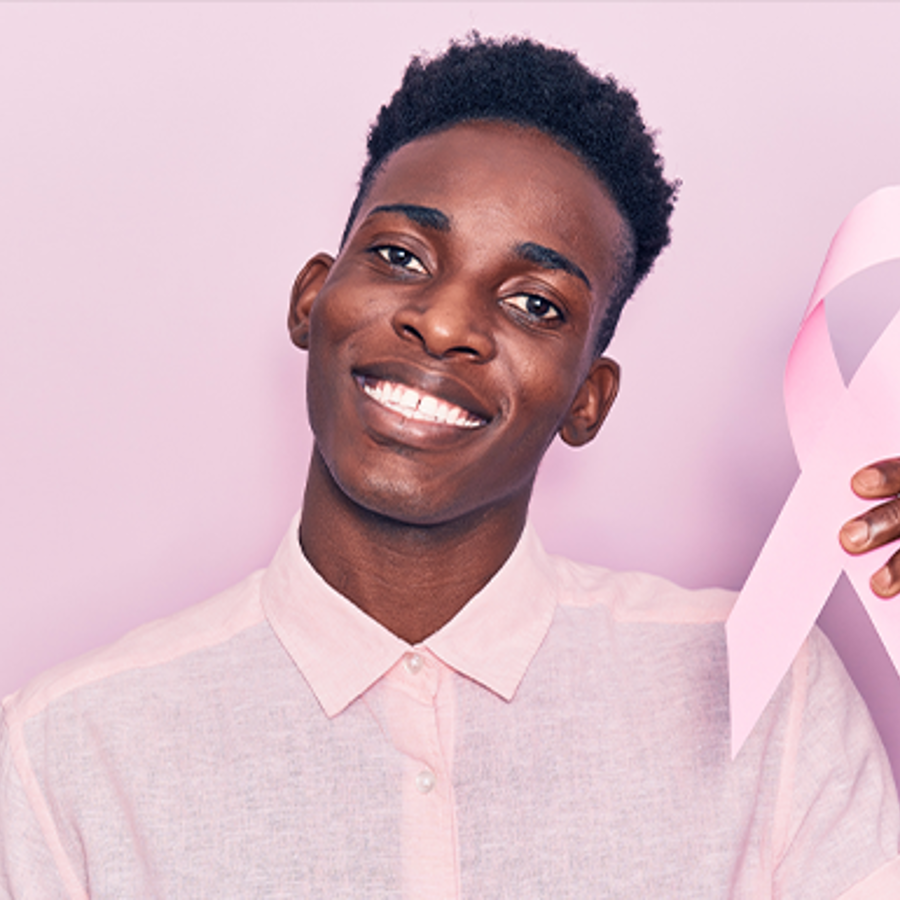
Is male breast cancer hereditary?
July 18, 2012

- Related Topics:
- Cancer,
- Complex traits
A curious adult from Illinois asks:
"I am aware that there is at least one gene that has been identified as indicating a heightened risk for breast cancer, so that a woman who has this gene may pass along this higher risk to her daughter. Has any work been done on the subject of genes that may be linked to male breast cancer, and if so, is there any information on whether a man who has breast cancer may pass on a higher risk of breast cancer to his daughter or son?"
Scientists have indeed found genes that can lead to increased risk for breast cancer in men. It turns out they are some of the same ones that increase a woman’s risk too.
This was pretty difficult to figure out for men because breast cancer is so rare for them. While one in eight women will get breast cancer in their lifetime, only one in 1000 men will1.
Scientists have found that certain differences in two genes can make it more likely for women to get breast cancer. These infamous genes, BRCA1 and BRCA2, also make it more likely for men to get breast cancer.
However, as you see from the table below, having these differences in the BRCA1 or BRCA2 genes are not as dangerous for men. Men with certain BRCA1 or BRCA2 differences certainly are at higher risk than men without these mutations, but the risk is much lower compared to women. In fact, their risk is less than women without these BRCA1 and BRCA2 differences.
Percent of People Who Get Breast Cancer
|
Women with... |
Men with...2 |
|
|
BRCA1 mutation |
1 to 2% |
|
|
BRCA2 mutation |
6-7% |
|
|
No BRCA1 or BRCA2 mutations |
0.1% |
Both men and women can pass their BRCA1 or BRCA2-dependent increased risk of breast cancer to their sons and daughters. This is true even if they do not develop breast cancer themselves.
Remember, having these differences does not mean you will get cancer for sure. In the worst case, 72% of women with the BRCA1 difference will develop breast cancer. This means that 28% with the BRCA1 difference won’t develop breast cancer.
But if the genetic difference is passed on, their child still has the increased risk whether or not mom (or dad) had breast cancer. And as you’ll see below, if either mom or dad has the difference, the child has a 50% chance of getting the BRCA mutation. Again this is true whether or not mom or dad developed breast cancer themselves.
Another way for men to have an increased risk for breast cancer is if they have Klinefelter’s Syndrome. Men with Klinefelter’s Syndrome have an extra X chromosome, so they have XXY instead of XY. Scientists think some of these men are at a higher risk because they make extra estrogen. But since these men tend to have very low fertility, they usually don’t pass the increased risk down to their sons*.
In the rest of my answer, I will talk about why BRCA1 and BRCA2 mutations can increase a person’s risk for cancer. In the end I think you’ll appreciate why not everyone with a bum BRCA1 gene ends up getting cancer. And why men are at a lower risk than women.
*Fathers pass on the Y chromosome to their sons, while they pass on the X chromosome to their daughters. Men with Klinefelter’s Syndrome could potentially pass the Y and the extra X chromosome onto their sons and pass on the increased risk for breast cancer and Klinefelter’s Syndrome. Men with Klinefelter’s Syndrome would not be able to pass their increased risk of breast cancer onto their daughters.
Cancer Happens Because of Mistakes in Genes
Normally, cells are very well behaved and carefully controlled by genes. They will only divide and grow when they are told to do so.
In cancer, a group of cells ignores their controlling genes and become unruly. They grow uncontrollably and/or refuse to die when they should. It is because of these cells’ unruliness that people get sick and sometimes die.
A common way for this to happen is when a cell develops a mistake (or mutation) in one of its controlling genes. Now the gene stops working and the cell goes rogue.
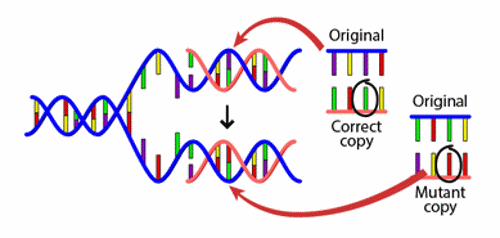
Mistakes are actually pretty common, but luckily most don’t matter. And for the few that do, our cells have genes that can fix them or that can force the cell with the mutation to kill itself.
Of course we are in trouble if the mutation is in one of our repair genes. Now the cell can’t fix this mutation or any new mutations because the repair gene is broken. This appears to be what is happening in cases where differences in BRCA1 and BRCA2 lead to increased cancer risk.
BRCA1 and BRCA2 are both involved in fixing genes. So if you are born with a mistake in one of these genes, then your cells end up with more mistakes. More mistakes means an increased risk that one of the mistakes will be in a key gene.
This is why both men and women are at an increased risk for breast cancer. But as you’ll see, women are at a higher risk because their breast cells have to copy their DNA way more than do men.
More Cell Divisions Means More Mistakes
Every time a cell divides, it needs to make a copy of its DNA. And every time a cell copies its DNA, there is a chance it will make a mistake. So it makes sense that the more divisions a cell makes, the more mistakes it will have.
A key point to remember is that the more mistakes there are, the more likely one is to be in a key gene. This is why women get breast cancer more often than men no matter what their BRCA1 and BRCA2 genes look like. Because the cells in female breasts divide more than those in male breasts.
It is also why not everyone with bum BRCA1 and/or BRCA2 genes ends up with cancer. Having a faulty repair system means you’ll have more mistakes but it doesn’t guarantee that any of the mistakes will be in an important gene.
So sometimes people with great repair systems get unlucky and have a key gene hit. And sometimes people with bad repair systems dodge a bullet and end up with lots of unimportant mistakes. Click here to dig a bit more deeply into this topic.
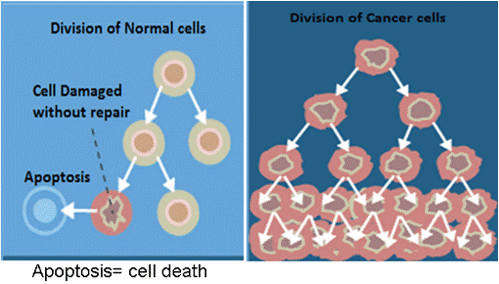
Bottom line is that if someone has a difference in BRCA1 or BRCA2 that leads to an increased risk for cancer, it does not mean that they will definitely get cancer. It just means they are at higher risk of getting breast cancer. Since breast cells in women divide more than they do in men, women have a much higher risk of breast cancer than men.
BRCA1 or BRCA2 Breast Cancer Risk Can Be Passed to Children
Like any other gene, BRCA1 and BRCA2 are passed from parent to child. Which means parents with “bad” BRCA1 or BRCA2 genes can pass these mutations onto their children. But as you’ll see, it isn’t a sure thing-- each child has only a 50% chance of inheriting the increased risk. Here’s why.
We each have two copies of most of our genes. So we have two copies of BRCA1 and two copies of BRCA2.
To be at an increased risk for cancer, only one copy has to have the differences we’ve been talking about. Scientists call this kind of thing a dominant trait. The dominant version (in this case, it’s being at an increased risk for cancer) wins out over the "normal'' version.
Children get half of their DNA from their mothers and the other half from their fathers. This means that they get one of mom’s BRCA1 genes and one of dad’s.
But which one they get is random. So if dad has a bad BRCA1 gene, then each child has a 50% chance of getting this one and a 50% chance of getting the one that works fine.
Let’s go through an example to show how this all works. Let’s say Jane’s dad is at an increased risk for breast cancer because he has one normal BRCA1 gene and one bum copy. Jane’s mom has two normal copies of the BRCA1 gene.
To simplify things from here on out, we’ll call the version that leads to increased risk BRCA1- and the one that doesn’t, BRCA1+. So Jane’s dad is BRCA1+/BRCA1- and Jane’s mom is BRCA1+/ BRCA1+.
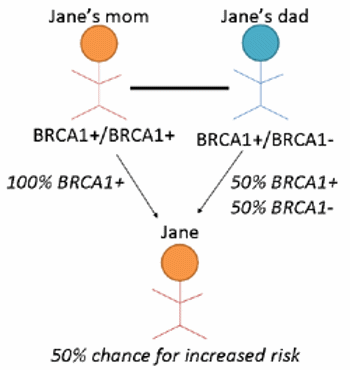
Jane can get either BRCA1- or BRCA1+ from her dad. Jane’s mom only has BRCA1+, so Jane will definitely get a normal BRCA1 from her mom.
Jane’s chances for being at an increased risk are 50% or 1 in 2. This is because the gene copy she gets from each parent is random. She has a 50% chance of getting BRCA1- and a 50% chance of a BRCA1+ from dad. (Mom will always give her a BRCA1+.)
So Jane could be BRCA1+/BRCA1- and be at higher risk OR she could be BRCA1+/BRCA1+ and be at normal risk. Remember that this is true whether or not Jane’s mom had breast cancer. Also remember that in both cases Jane can still get breast cancer. It is just more likely she will get breast cancer if she is BRCA1+/BRCA1-.
There you have it. Scientists have indeed found genes that increase a man’s risks for breast cancer. But none affect men as much as they affect women.
A More Complicated Example
For those of you who really like figuring out genetics, here is one more example. Let’s say Bob’s mom is BRCA1+/BRCA1-, meaning she has one good copy of BRCA1 and one bum copy of BRCA1. Bob’s mom is at increased risk for breast cancer.
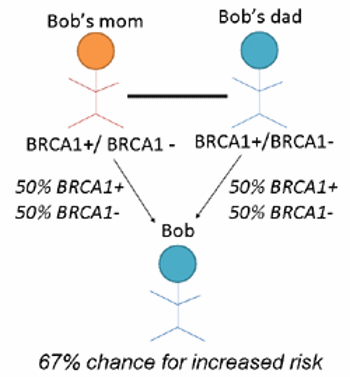
Bob’s dad is also BRCA1+/BRCA1-, meaning he has one good copy of BRCA1 and one bum copy of BRCA1. Bob’s dad is also at increased risk for breast cancer.
Bob can get either BRCA1+ or BRCA1- from his dad. Bob can also get either BRCA1+ or BRCA1- from his dad.
Bob can be any of the following:
- BRCA1+/ BRCA1+
- BRCA1+/ BRCA1-
- BRCA1-/ BRCA1-
If Bob gets a normal copy of BRCA1 from both his mom and dad, he will be BRCA1+/BRCA1 +. But there are a couple of different ways to end up BRCA1+/ BRCA1-.
He can get BRCA1+ from his mom, and BRCA1- from his dad. He could also get BRCA1- from his mom, and BRCA1- from his dad.
From just the genetics, it looks like if Bob got BRCA1- from both of his parents, he could be BRCA1-/ BRCA1 -. But no one has ever found anyone who was BRCA1-/BRCA1-. Most likely these people die in the womb and so they are not born.
OK, so Bob couldn’t be BRCA1-/BRCA1-. This means that since he is alive, he has a 1 in 3 chance of being BRCA1+/BRCA1+ and a 2 in 3 chance that he will be BRCA1+/ BRCA1 – and be at an increased risk for breast cancer.
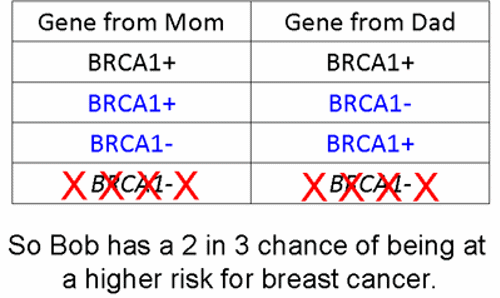

Author: Mei-Hsin Cheng
When this answer was published in 2012, Mei-Hsin was a Ph.D. candidate in the Department of Genetics, studying epigenetic regulation in drosophila in Joseph Lipsick’s laboratory. Mei-Hsin wrote this answer while participating in the Stanford at The Tech program.
 Skip Navigation
Skip Navigation
